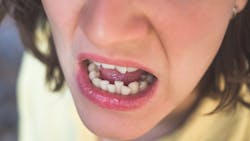Gum disease, also called periodontal disease, is caused by specific bacteria in the mouth, and can be present in cases involving malocclusions—when the teeth aren’t aligned—as it’s harder to ensure proper cleaning to remove plaque. The bacteria on their own cannot cause gum disease; the body’s inflammatory response must be activated as well. It is the bacteria that ignite the inflammatory response, which is the primary cause of gum tissue inflammation.
So, in short, when there are enough of certain oral bacteria, the body’s protective inflammatory response is activated. The inflammatory response is accompanied by the release of a variety of enzymes, white blood cells, and signaling molecules. The enzymes include those that damage the gum tissue and bone around the teeth.1
There are approximately 1,000 species of bacteria and other microorganisms in the mouth with a total population in the billions.2 Some of these bacteria have a very strong ability to cause gum disease, and others less so. Any areas in the mouth in which bacteria accumulate have a greater tendency to develop gum disease. It’s a very simple formula: more bacteria, more inflammation; fewer bacteria, less inflammation.1-3 Areas of the mouth that are less accessible to homecare devices such as toothbrushes, floss, and picks, and professional devices such as ultrasonic scalers, are at risk for bacterial accumulation.
Crooked teeth: A notable exception
These areas include the back of the mouth, particularly the inner surfaces of the teeth adjacent to the tongue or palate. The front teeth are easily accessible and tend to accumulate less bacteria and are more easily cleaned at home and in the dental office, so there tends to be less incidence of gum disease there. But there’s a notable exception: crooked, or crowded teeth.
Crooked teeth, anywhere in the mouth, have overlapping sides or edges as opposed to straight, properly aligned teeth. These overlapping edges create corners that are an ideal niche for bacterial accumulation. Wherever two surfaces meet an angle is formed. This is the case with two walls in a room or with crowded teeth. More dust and debris accumulate in the corners of a room as anyone who has swept a floor knows. Straight teeth, however, have no overlap, so corners are not created, and the bacterial buildup of these teeth is considerably less than with those that are crowded.
The benefits to correcting crooked teeth
So, in addition to correcting crooked teeth for esthetics, there is a significant clinical benefit. Correcting crowded teeth will remove the areas for bacteria to build up by properly aligning the teeth and eliminating the corners created by overlapping teeth. Patients with active gum disease should have it treated before having orthodontic treatment. Clear aligner treatment will not resolve gum disease; that can only be accomplished by appropriate periodontal therapy. But fixing crowding with clear aligners will help reduce the accumulation of the primary cause of gum disease, namely bacteria, so correcting crooked teeth reduces the risk for the development of gum disease.
Historically, orthodontics had largely been confined to adolescents and before the availability of clear aligners, was accomplished with wires, bands, and brackets that are not removable throughout the treatment process. The launch of clear aligners 24 years ago revolutionized orthodontic care in a couple of ways. The removable nature of aligners facilitates homecare and professional care, and their transparent appearance has led to a skyrocketing number of adults having orthodontic treatment. According to the American Association of Orthodontists (AAO), approximately 1.5 million adults in the US are having orthodontic treatment.4
Many companies now offer clear aligners. A recent entry in the market is OraFit, provided by OraPharma. Consider OraFit as a new alternative for clear aligner therapy.
References
- Pihlstrom BL, Michalowicz BS, Johnson NW. Periodontal diseases. Lancet. 2005 Nov 19;366(9499):1809-20. doi: 10.1016/S0140-6736(05)67728-8. PMID: 16298220.
- Radaic A, Kapila YL. The oralome and its dysbiosis: New insights into oral microbiome-host interactions. Comput Struct Biotechnol J. 2021 Feb 27;19:1335-1360. doi: 10.1016/j.csbj.2021.02.010. PMID: 33777334; PMCID: PMC7960681.
- Krishnan K, Chen T, Paster BJ. A practical guide to the oral microbiome and its relation to health and disease. Oral Dis. 2017 Apr;23(3):276-286. doi: 10.1111/odi.12509. Epub 2016 Jul 4. PMID: 27219464; PMCID: PMC5122475.
- 7 myths about orthodontic treatment. American Association of Orthodontists. January 13, 2020. Accessed April 4, 2022. https://www3.aaoinfo.org/blog/7-myths-about-orthodontic-treatment/
About the Author
Richard H. Nagelberg, DDS
Richard H. Nagelberg, DDS, has practiced general dentistry in suburban Philadelphia for more than 30 years. He has served on many advisory boards and as a consultant and key opinion leader for a variety of companies and organizations. Dr. Nagelberg is the Director of Medical Affairs at OraPharma, a division of Bausch Health US, LLC. His practice and other professional activities are centered on the impact dental professionals have beyond the oral cavity. Contact Dr. Nagelberg at [email protected].
Updated May 2022

